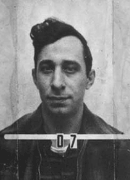Richard F. Taschek (1915-2005) was a nuclear physicist at the Manhattan Project’s Los Alamos facility and the Los Alamos National Laboratory.
He was born on June 5, 1915, in Chicago, Illinois. In 1936, he received a B.A. in physics and mathematics from the University of Wisconsin and an M.S. in physics from the University of Florida. After earning his master’s degree, he returned to the University of Wisconsin in 1938 to work toward his Ph.D. while doing research under Gregory Breit. His research focused on proton-proton and proton-deuteron scattering at low energies. He earned his Ph.D. in physics in June of 1941.
In the later part of 1942, Taschek began working on the isotron project at Princeton with Robert “Bob” Wilson and Henry DeWolf Smyth. When the isotron project was transferred to Los Alamos in 1943, Taschek and his wife, Inez, and infant daughter, Katrine, relocated to the Manhattan Project site. At Los Alamos, he worked in the electrostatic accelerator group, which measured various fast-neutron cross sections.
After the war, he continued to work at Los Alamos, which became the Los Alamos National Laboratory (LANL). According to a short autobiographic introduction written by Taschek, he decided to stay at Los Alamos because he found the research facilities and New Mexico location “met all [his] desires as a place to live, play, and work.” While at LANL, Taschek continued to do research, but he also began to take on administrative roles as well. Most notably, he served as Physics (P) Division Leader (1962-1970) and Associate Director for Research. In their interviews for the Atomic Heritage Foundation’s “Voices of the Manhattan Project” website, both Eulalia Quintana Newton and Harold Agnews recall meeting and working with Taschek at LANL.
At LANL, Taschek worked alongside Jerry Conner, another nuclear physicist. In an oral history with the American Institute of Physics, Conner described Taschek as a “pretty good politician,” who had an interest in the Atomic Energy Commission’s policy work, such as issues surrounding a test ban treaty. In 1979, Taschek retired from formal work at LANL, but he continued to serve as a consultant.
Taschek died in 2005 at the age of 90 years old.
For more information about Taschek and his nuclear physics work, please read these references and sources:
Interview with John Manley, Ben Diven and Richard Taschek by Science
“Accelerator breeding of fissile materials” by Robert F. Taschek
Physics Division Progress Report: Special 50th Anniversary Issue





